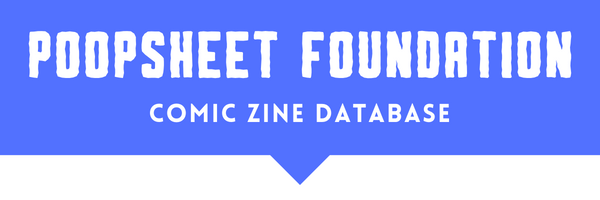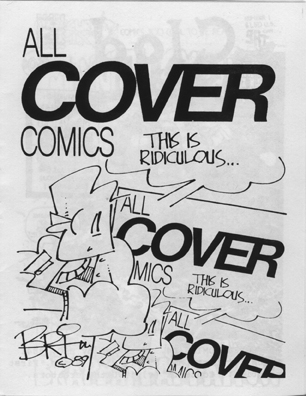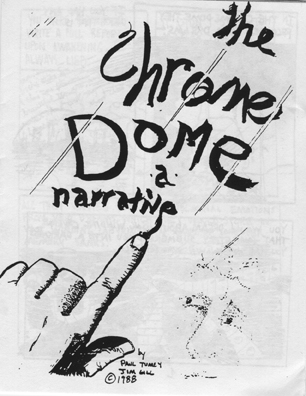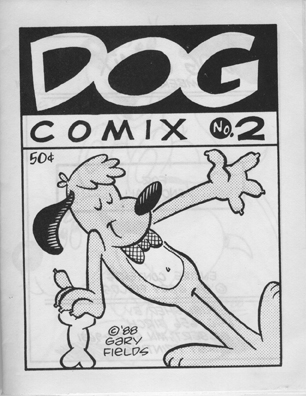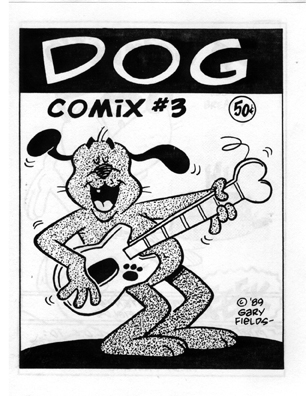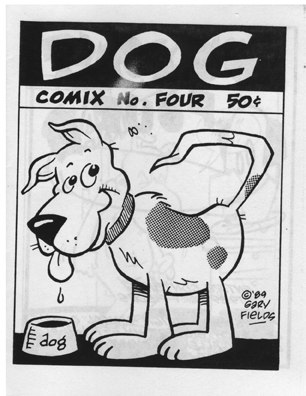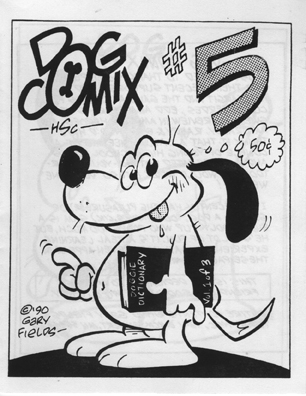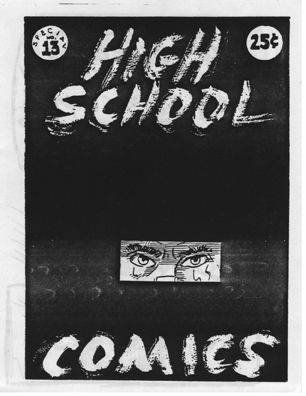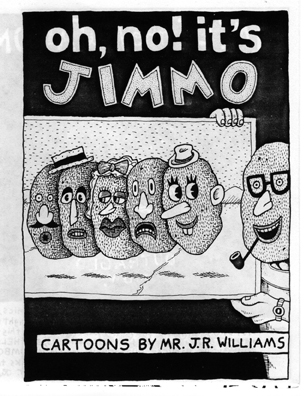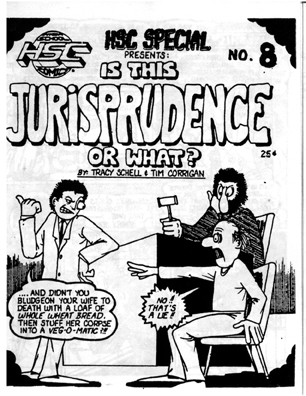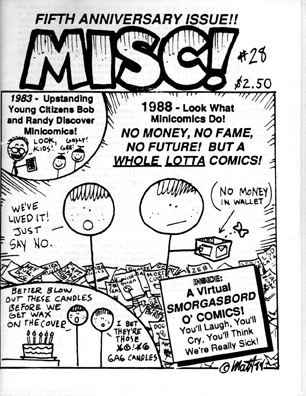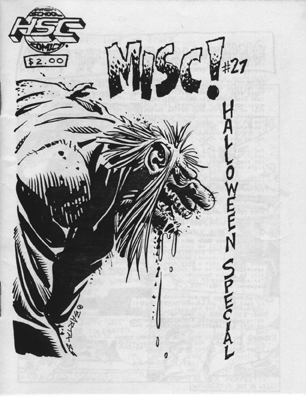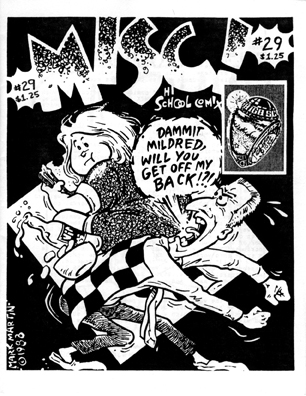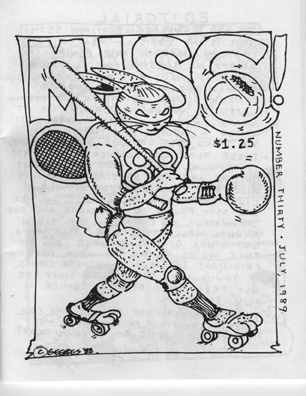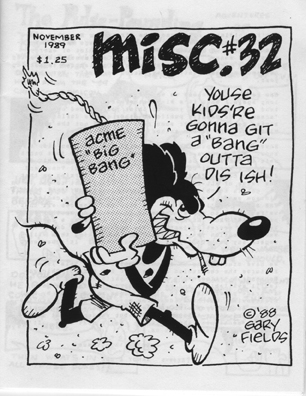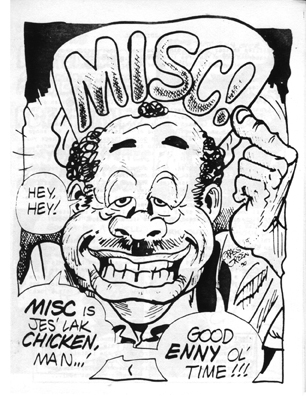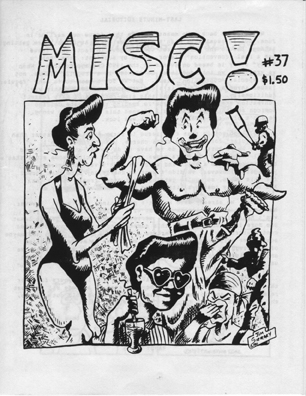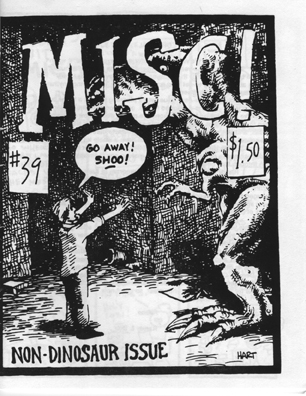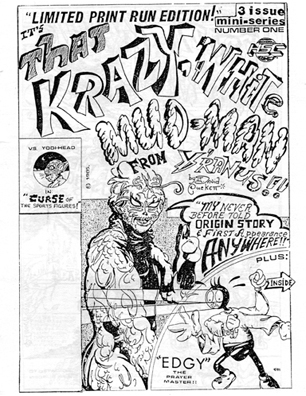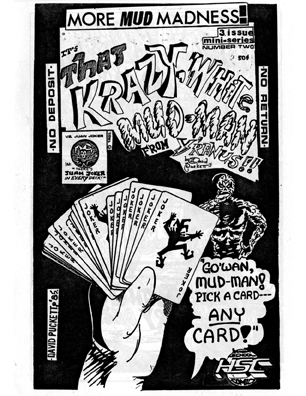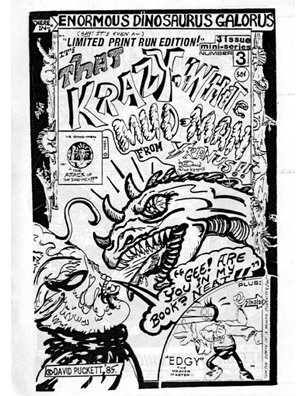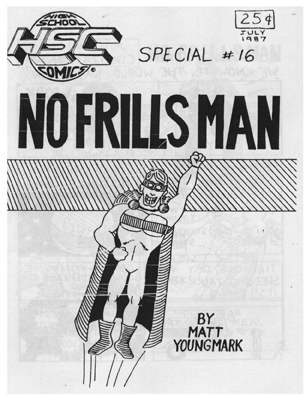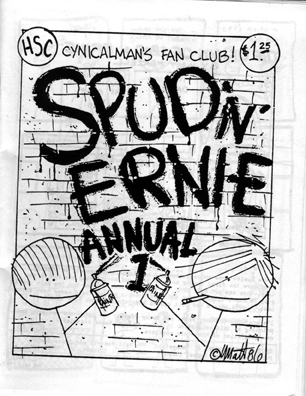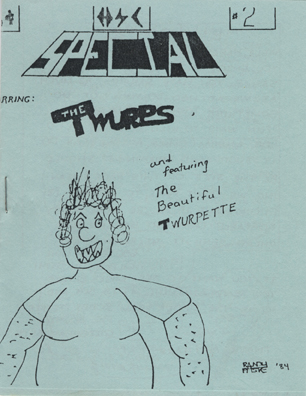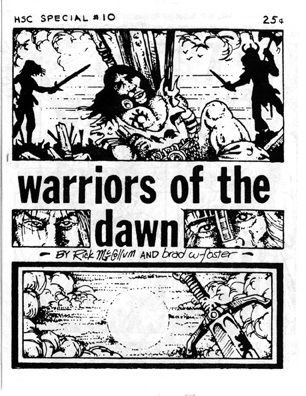David Lee Ingersoll interviews Bob Pfeffer about High School Comics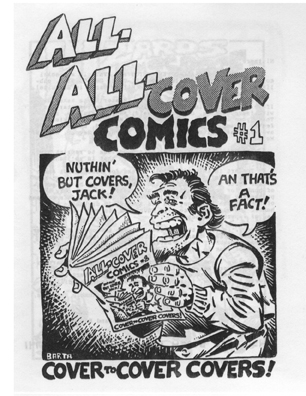
In 1988 I was inspired to create my first minicomics when Bill Ehmann Jr. mailed me an envelope full of them. Before I opened that envelope I’d never seen a minicomic. I’d been putting up posters around town (Santa Rosa, CA) advertising my services as an illustrator. I never got a job from those posters but I did inspire someone to send me the minicomics he’d created. Seeing them was like a light bulb going on for me. I’d been wanting to create comics my whole life but my art wasn’t slick or professional enough for me to think I’d have any success submitting to any of the publishers I was aware of. I did, however, know how to use a photocopier and I could fold and staple paper. I could write a story. I could draw a comic book page. Maybe I wasn't ready for the big time but I was ready to be a minicomics publisher.
I spent the next two years making minicomics. I sent my little books to Factsheet Five and any other place that said it would review them. I sold and traded minicomics through the mail. After awhile I started contributing art to zines and other minicomics. One of the publishers who took a lot of my art was High School Comics. HSC was run by Randy Paske and Bob Pfeffer. Earlier this year, when I considered posting my contributions to All Cover Comics, I did some online searches to see what sort of info there was out there about HSC. I found next to nothing.That seemed like a shame so I figured I should do something about it. Fortunately I’m linked with Randy and Bob via Facebook. I emailed them to see if they could take time out of their real lives to dredge up the past. Bob found the time to type out some very thorough answers to my questions. Randy has been doing a lot of overtime so he wasn't able join us but he did get to read and approve this interview before I posted it.
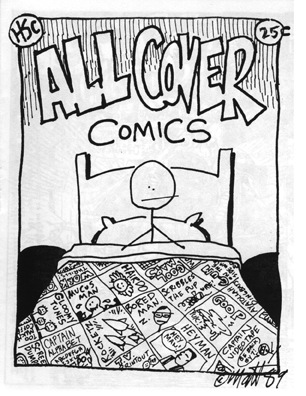
Ladies and Gentlemen, Boys and Girls, please welcome Bob Pfeffer, former publisher of High School Comics!
DAVID: Bob, thank you for taking to time to do this interview. Beginning at the beginning; what inspired you to publish minicomics?
BOB: Both Randy and I lived in Gilbert, Minnesota which is a small town in northern Minnesota. We were the only comic book fans that we know of in our class. There were no comic book shops near us, and we had to buy comics from a small local newsstand. This was in the early 1980s. When I was in, I think, 7th grade, I got to go to a comic book convention in Minneapolis, which is a four-hour drive from Gilbert, so it was a big deal. Randy wasn’t at that convention. While I was wandering around looking at comics I was at a booth talking to two guys who ran it. During the course of the conversion they gave me some mini-comics they had done. They were Dennis Schultz and Jim Kevins and their mini was called Officer Byrd. I thought it was pretty funny and I thought it was really neat they these guys made it themselves.
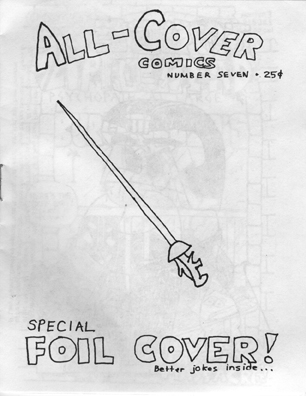
When I got back home I showed it to Randy and he was interested too. The next year we both attended the convention and I wanted to find more of those mini-comics. I saw someone with a booth selling them, so I asked if he know about Officer Byrd. He did and he had some, plus a lot of other ones as well. I had no idea that there were some many people making mini-comics. That person was Matt Feazell and he was very helpful in explaining how to make your own comics. His comics were so wonderful and simple looking that it convinced us we could do it too.
After the convention Randy and I decided to try to do some of our own minis. We printed up probably 20 copies of HSC Presents, with two stories, one by Randy about the Pillsbury Doughboy and one by me called EAKM (Everyday Average Kid Man). It was 8 pages and really badly drawn. Neither of us could really draw, and though over time Randy got passable at it, I soon quit trying to cartoon and just wrote stories for other people to draw.
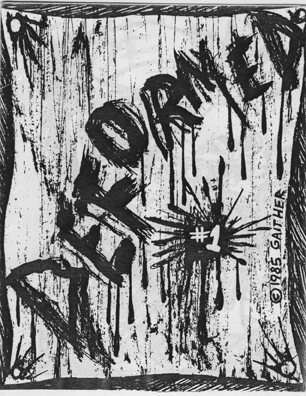
We sent this to Matt Feazell and he gave us a bunch of addresses of other who published mini-comics who would trade their books for ours. We met lots of really cool and interesting people doing this, and started many friendships through it. We started communication with a bunch of other cartoonists and decided to try and publish stuff from them as well as just our own work. MISC! was our anthology title and was soon our most popular comic.
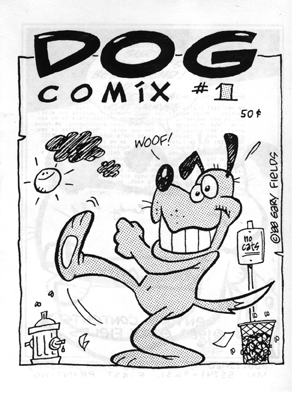 We were in junior high when we started publishing, and it was just awful. The contrast between the demeaning and pointless existence we had to endure during the school hours and creative and rewarding experience of the world of self-publishing is too big to even contemplate. Self-publishing really helped make life worthwhile during this period and once we started we really put all our energy into it. We wrote stories, contacted artists, printed and put the comics together, mailed them out and maintained dozens and dozens of correspondence with other small-pressers. It was amazing to be part of that culture.
We were in junior high when we started publishing, and it was just awful. The contrast between the demeaning and pointless existence we had to endure during the school hours and creative and rewarding experience of the world of self-publishing is too big to even contemplate. Self-publishing really helped make life worthwhile during this period and once we started we really put all our energy into it. We wrote stories, contacted artists, printed and put the comics together, mailed them out and maintained dozens and dozens of correspondence with other small-pressers. It was amazing to be part of that culture.
We started going the the Chicago Comic Con which was HUGE and had a large gathering of small press publishers there. We even got on the guest list a few times and spoke on a panel or two. It was really great to be part of that world.
DAVID: How did the two of you work together?
BOB: In the early years we wrote stories separately. Randy would draw some of his, or send them out to others to draw. I stopped drawing my stuff pretty early. Later, particularly when we got out of high school, we started writing together. We would get together for an evening and just throw ideas at each other. We would start to laugh at some of them and begin to write them down until we had some sort of a story. We started doing “Bob and Randy” stories where we were the main characters and we put ourselves in completely absurd situations. I think these are my favorite things that we ever published. Scott McClung did the artwork for a bunch of these, and they were always wonderfully cartooned.
As far as the actual production, Randy kept up correspondence with about half of the people and I had the other half. After school we would read the mail we got to each other over the phone. We would get the art together, do paste ups (actually tape ups) and layout. Randy did most of that. I would do most of the actual printing. First using the printers I could get a hold of at my Mom’s or Dad’s work. After awhile we started using real printers. I remember getting together to have collating parties when we were printing 1000 copies of MISC! and those were usually quite big, from 32 - 48 pages, though our Halloween issues could get over 100 pages.
DAVID: I called my company Obscure Komix because, well, I didn’t expect to reach a huge audience with them. Where did the name High School Comics come from?
BOB: We were in high school at the time and we thought that was going to be unique in that we were so young and were doing mini-comics. It turns out it wasn’t so unique, there were several other groups our age doing the same thing, the APC guys out of Wisconsin and the Captain Spaz guys from New York being a few others.
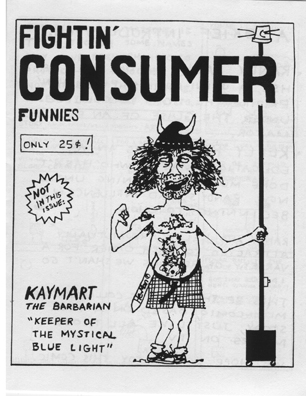
DAVID: What titles did you publish?
BOB: MISC! was the big one, but we put out many many other titles. Social Commentary For Our Times, Erwin Mouse, HSC Presents, Carrot Man, All-Cover Comics are just a few off the top of my head.
DAVID: How many issues did you publish?
BOB: I would guess near 100 but Randy would probably have a more complete list.
DAVID: How did you distribute the minicomics?
BOB: We started by trading with contacts supplied by Matt Feazell. Those lead to other contacts. Then there were the small press “newpapers” like Fandom Times, SPCE, Comics Fandom Examiner, etc. We would get reviews in those and people would get in contact and buy our stuff. We had a brief failed experience of having our stuff distributed by Friendly Frank’s during the black and white glut. We never got paid for those, though I did get to see a copy of MISC! in the bargain bin at the big Shinders Books in downtown Minneapolis as a result of that.
DAVID: How long did HSC exist?
BOB: I think it sort of petered out when Randy and I went to grad school in different states and it made it too hard to really do much publishing. Randy did some stuff more or less by himself in the end but after our undergrad days were over we pretty much moved on to other things.
DAVID: What do you consider your best comics, both those created by yourself and those that HSC published?
BOB: I liked the later MISC! comics the best, I think we really hit our stride, both the Bob and Randy stories and the other stuff we published. We had some tremendous people doing stuff for us.
All the Doughboy stories are great too. I have a soft spot in my heart for Fun Ways To Kill Smurfs.
DAVID: What sort of comics were you reading at the time? How did those comics influence what you decided to publish?
BOB: When we first started I was reading things like New Teen Titans and X-Men. Soon after I started reading my indy type stuff, like Zot. I dropped all the mainstream stuff pretty quickly, it seemed really lame compared to the more interesting indy books. I’ve stayed interested in comics, but mainly things like Seth’s work, or Chester Brown, etc. Currently I mainly read older stuff, like John Stanley’s Little Lulu.
DAVID: Where did you find contributors to HSC?
BOB:In the beginning we just made contact with as many other publishers as we could, trading minis and writing letters back and forth. We also got our stuff reviewed all the different places you could get reviewed.
DAVID: How many different people contributed art and stories over the years?
BOB: Wow, I really don’t know. Randy might have that number, I would guess over 100.
DAVID: I’ve looked over the HSC minicomics I own and the catalogs included in some of the envelopes and came up with a partial list of contributors. It’s a veritable who’s who of minicomics folk::
Sergio Aragones, Sam Arroyo, Cary Lee Baker, Hilary Barta, Mark Bartholomew, Ken Barnes, Jeff Bauman, Eddie Bocage, Greg Boettcher, Ted Bollman, Matt Borders, Rick Borscht!, Rick Bradford, Randy Brown, Jeff Bryk, Buck & Wing(Ted Bollman), Chuck Bunker, Randy Carpenter, Bill Cairns, Mike Cherry, Mark Choate, Sean Cliver, Tim Corrigan, Paul Curtis, Dee, Tim DeGroot, Art Delano, Roy Delgado, Clark Dissmeyer, Neil Dorsett, John E., Kevin Eldridge, L.C. Falby, David K. Farley, Timothy Fay, Matt Feazell, John Fellows, Gary Fields, Bill Fitts, Stephen Fitzpatrick, Brad Foster, Alan Freeman, Paul Fricke, Jeff Gaither, Clay Geerdes, Sam Gifford, James Gill, Kenneth Greche, Kenneth P. Greene, Rodney E. Griffith, Jules Hart, Mike Hartzell, Sam Henderson, Kelly Higgins, Doug Holverson, Wayne Honath, Daryl Hutchinson, Joe Hutchinson, David Lee Ingersoll, Jeremie Johnson, Dan Kaufman, Alex LaVerde, Steve Leach, Leary, Robert Leever, Brian Leonard, Robert Lewis, Liszewski, Ben Lord, Phil Luttrell, Russ Maheras, Terry Manderfeld, Francis Mao, Larry Marder, Mark Martin, Don Martinec, Richard Mayhew, Scott McClung, Rick McCollum, John Miller, Paul Minnich, John Mobbs III, Greg Nelson, Tony Nichols, Jeff Nicholson, Mitch O’Connell, Scott Onickel, Brad Overacker, Randy Paske, Patton, Brian Pearce, Faye Perozich, John Peter, Bob Pfeffer, W.C. Pope, Irvin Prowell, David Puckett, Chris Purcell, Todd Ritter, Lon Roberts, Todd Rush, Ken Sanzel, Tracy Schell, Jonathan Schockley, Jim Siergey, Stump, Rob Sturma, Bob Supina, Dan W. Taylor, Taylor/Margot, Bruce Temmel, Brian Thomas, Richard Thomas, David Tinnat, Paul Tumey, Stephen Tuttle, Colin Upton, Chris Vargas, V-X, Pee Wee Warhol, Bobby Weiss, J.R. Williams, R.Larry Williams, Steve Willis, Gary Wray, Craig Young, Frank Young, Matt Youngmark, Joe Zabel
DAVID: Of the minicomics that you got from other publishers, which titles stand out? What artists did work that you remember?
BOB: Wow, that is an impossible question. There were so many good writers, artists and cartoonists that singling just a few is really difficult. Matt Feazell really was a huge influence. He created (and is still creating) really awesome mini-comics, plus his philosophy behind self-publishing influenced both of us tremendously. The whole punk DIY sort of attitude really spoke to us. And he drew absolutely the BEST stick figures.
Steve Willis, of course, is awesome. Anything he did was great, and sometimes mind-blowing in a sense to a naive teenager from a small town in northern Minnesota. I remember eagerly reading each issue of The Tragedy of Morty when I got one.
I really liked John Mobbs II's Tomato-Man comics, they seemed like perfect little mini comics to me.
Captain Spaz from Bobby Weiss and Sam Henderson was always really funny.
Tim Corrigan put out some really good mini comics.
Jeff Nicholson is an amazing cartoonist.
J.R. Williams, Paul Tumey, Jim Gill, Frank Young, Colin Upton, Scott McClung, Brad W. Foster did some really good work. There a tons of others I am missing of course.
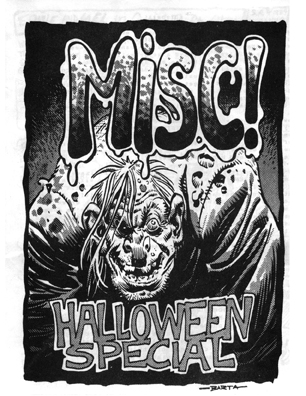
DAVID: Randy and I traded letters along with minicomics. A couple of those missives concerned a debate the two of you had concerning my use of the “F” word in one of my stories. I don’t remember what I wrote in response but I think I was a little surprised that the word bothered you. I’d sometimes tried to be purposely offensive with my own publications. Did you have a particular audience in mind for your comics?
Well, when we started we were kids, and our folks saw what we did and we didn’t really want to do anything we couldn’t show our parents. I don’t know, it just didn’t seem right to have a lot of swearing or sex in our mini comics. There were some that sort of pushed that line, and I can see how you could call us hypocritical because we had no qualms about using violent for comedic(?) purposes but that is just want felt right to us. I guess we tried not to be purposely offensive, unless you really liked tge Smurfs, Snuggle or the Pilsbury Doughboy.
DAVID: I was reminded of my minicomics career by reading Newave!: The Underground Mini Comics of the 1980s by Michael Dowers. The book reproduces art from and has interviews with folks who were doing minicomics in the early Eighties. A few of them contributed to your comics as well. One of the questions that Dowers asked a lot of the artists was: What did you get out of doing minicomics? Did it lead to anything bigger or was it a waste of time?
I got a lot of out doing mini comics. It was my entry into a subculture of cool and creative people, and it gave me a constructive outlet for all the frustrations of adolescence. I liked writing letters and communicating with such a wide variety of really interesting characters, in was a world totally different that my day-to-day world. We lived in a boring little town, with not much going on, and the whole world just started to open up to me once I got involved with mini-comics.
As far as a career path, sure it would have been great to be a comic writer or a publisher and get paid for it, but that was never really our goal. We did it because we enjoyed doing it and being part of that community. We liked the people who were part of that subculture. If something happened more than that, great, but that was never the focus. We enjoyed it when people we knew reached a higher level of success, like Jeff Nicholson or Colin Upton or Chester Brown but we weren’t really trying to do that.
All images included in this interview are © the respective artists.
Bob Pfeffer can be emailed at the address: bobpfef @ gmail.com
